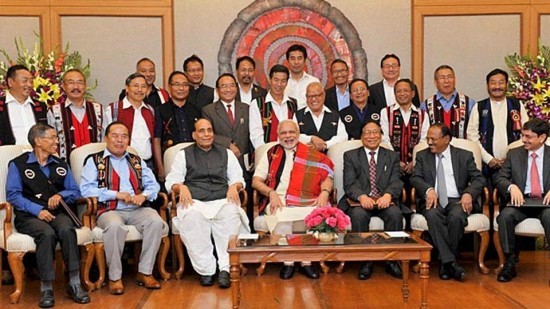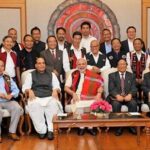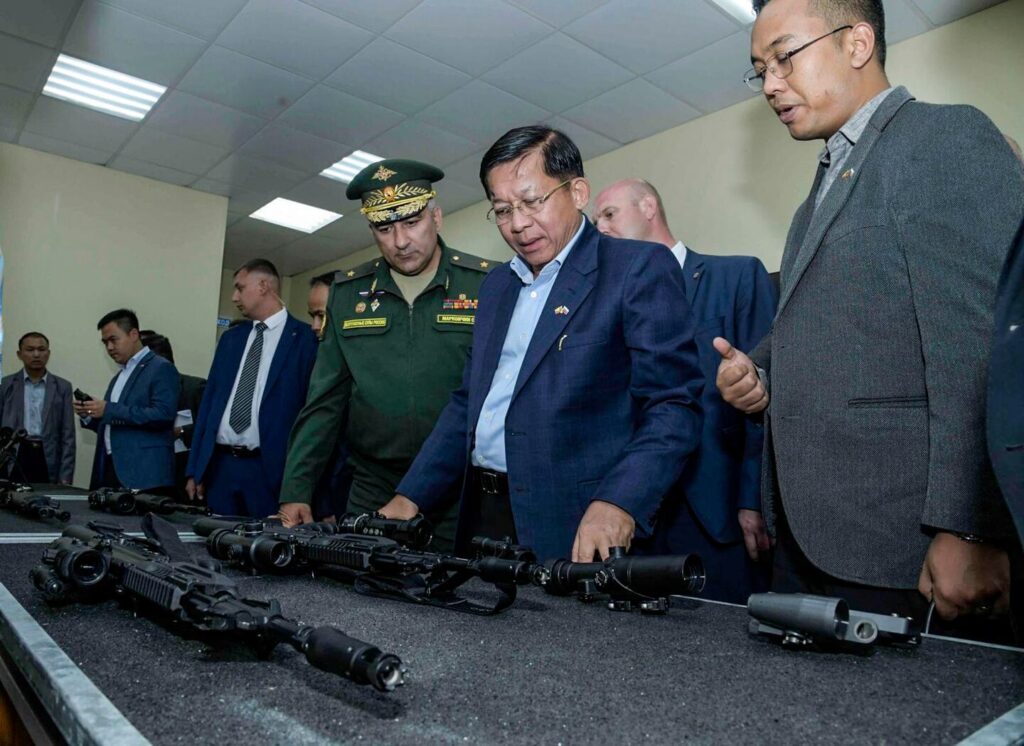MANTRAYA ANALYSIS#38: 10 JULY 2019
BIBHU PRASAD ROUTRAY
Abstract
How does an insurgency movement engaged in peace talks with the government generate its finances? Should the government attempt to curb its extortion activities that retains not only its structural violence instrumentalities, but also the options of indefinitely prolonging the negotiations? Should the peace negotiations strictly enforce a no-extortion clause to succeed? This article delves into the economics of the NSCN-IM’s commitment behind negotiations with the government.

(Prime Minister Narendra Modi with Chairman of NSCN-IM Isak Chishi Swu, the group’s General Secretary Thuingaleng Muivah at the signing ceremony of framework accord in New Delhi on 3 August 2015. Photo Courtesy: Hindustan Times)
Introduction
They are two sides locked in a ceasefire agreement since 1997 and a framework agreement since 2015. And yet, not just is there any final solution in sight, the views propagated by them remain sharply contrasting. From time to time, Government of India has tried to project a picture of optimism in Nagaland indicating that a final peace agreement with the ‘mother of all insurgencies’ in its northeastern region, the National Socialist Council of Nagaland-Isak-Muivah (NSCN-IM) could be round the corner. Such statements have invariably been refuted by the group’s leadership who assert that “Nagas will never surrender their rights and the Naga national movement spearheaded by NSCN is a people’s movement.”[1] A probe into this persistence is key to understanding why insurgencies involved in prolonged negotiations with the government continue to resist a final solution. While several factors such as hard bargaining account for the state of affairs, a key reason is the group’s elaborate and dynamic model of levy collection, which generates enough finances.
Influence of the NSCN-IM
The NSCN-IM, founded in 1980 and signatory to a ceasefire agreement with the Government of India since 1997, signed a framework agreement with New Delhi in August 2015. Although the agreement contained only a pathway to future negotiations, the government projected it as a major breakthrough towards peace in the region. Since then, negotiations have continued accompanied by recurrent media reports of a soon-to-be-signed deal.
Chairman of the group Isak Chisi Swu passed away in June 2016. Since then, the group is being solely led by Thuingaleng Muivah, the 85-year-old founding leader of the group with an avowed commitment to an independent Nagaland. Hopes that either the framework agreement would force a final deal down the throat of the group or the demise of Isak Swu would push Muivah to seal a deal within his own lifetime has been belied.
Not many encounters take place in Nagaland, Manipur, Assam and Arunachal Pradesh. However, facts on the ground indicate prevalence of what can be defined as uninhibited structural violence perpetrated by the insurgents against the civilian population. These include coercion, abductions, extortion, recruitment of cadres and silencing of the opposition by rival groups. Odd acts of violence like the killing of a member of the legislative assembly in Arunachal Pradesh in May 2019[2] are extensions of the group’s undiminished violence potential. To that extent, unauthorized hideouts of the group, set up in Manipur and Arunachal Pradesh project its strength and maintains its influence. According to terms of the ceasefire agreement, the NSCN-IM cadres are supposed to stay in the designated camps of the outfit. Any movement with arms outside the camp areas are prohibited. While these terms have been violated with impunity since the 1997 ceasefire agreement, the framework agreement of 2015 does not seem to have made any difference to the state of affairs.
Another factor which could have added to the group’s potency is the weakening of most of its rival groups like the NSCN-K within the state. The latter, after the death of its patriarch S S Khaplang in June 2017, has become a poor replica of itself. It has undergone several splits and has been battered regularly by security force operations within Myanmar. Its ‘Indian Naga’ leadership, who are now based in Nagaland, is more interested in being roped into a ceasefire agreement like the IM group than continuing an insurgency movement. As a result, the NSCN-IM remains the only group in Nagaland that stands tall with an agenda for independence.
Conflict Economy
On 18 and 19 March 2019, the NSCN-IM held its budget session for 2019-20 at its headquarters at Camp Hebron. It was attended by most of its senior functionaries from all over the state.[3] Although the net amount of the budget remains a tightly held secret, it is believed to be substantially more than its 2016-17 budget of Rupees 170 crore.[4]
In its hey days of active insurgency as well as in the years since the 1997 ceasefire agreement, the NSCN-IM, like all other armed organisations in the region, has relied on an elaborate levy collecting infrastructure to manage its day to day running costs as well as maintaining an expanded cadre base who are battle ready. Most government departments, politicians, contractors, civilians, and business establishments in Nagaland and inter-state border regions of Assam, Manipur and Arunachal Pradesh paid a part of their salary to the group as protection money. Transport and private vehicles passing through Nagaland and Manipur paid a fee at specially set up check points. The NSCN-IM defended its right to collect ‘taxes’ from the population in areas under its control. Media reports even indicated that to keep the ceasefire agreement on track, the Government of India periodically passed on some amount of money to the organization. Whether a similar arrangement since the 2015 framework agreement is in vogue is not known.
In any event, such sum would hardly be sufficient to maintain the group’s elaborate administrative structure spread over four states, its headquarter at Camp Hebron, and also to pay for its 5000 cadres[5]. It is, hence, unimaginable that the outfit would have dismantled its tax collection infrastructure even as it negotiates its future. Several incidents in recent past have revealed details of the elaborate levy collection network of the group in four states: Nagaland, Assam, Manipur, and Arunachal Pradesh.
On 29 June, an NSCN-IM ‘tax collector’, identified as Khemphai Wangsu, was arrested by police in Dibrugarh in eastern Assam along with another cadre, Md Kazimuddin, who worked as a driver. Further investigations led to arrest four more persons from Arunachal Pradesh from whom currency notes worth Rupees 1.5 million were recovered. These included two junior engineers, one assistant engineer, and another a lower division clerk of the Rural Works Department of Arunachal Pradesh government. Wangshu worked as the overall in charge of the outfit tasked with collecting money from ground level operatives in Assam and Arunachal Pradesh.[6] The instance of government employees collecting money on behalf of the outfit from officials from various government departments and passing on to the outfit is not new.
Setting up of unauthorized camps in remote areas where the group’s armed cadres collect money from the civilian population and business establishments is another mode of levy collection. On 6 July, Indian Army personnel dismantled such a hideout of NSCN-IM in Manipur’s Kakru Naga village. An M16 assault rifle with 125 rounds, one self-loading rifle with 26 rounds and unspecified number of AK series assault rifles were recovered. A lone cadre of the group, in civvies, was arrested.
On highways running through Nagaland and Manipur, and in commercial townships such as Dimapur, NSCN-IM’s collection units, consisting of both Nagas and non-Naga people, target trucks and business establishments. Even the auto-drivers and vegetable and fish vendors are not spared. On 15 March, two members of such a unit were arrested for extortion from truck drivers. Cash receipts and a sum of Rupees 4,300 were recovered from them. Another member was arrested at Rail Bazar in Dimapur district with Rupees 1920 on the same day. A week later, yet another member was arrested a country-made pistol and Rupees 8650 from Dimapur. While the recovered sum in these instances are small, the geographical spread of the extortion network in four states of the region could indeed be generating a substantial amount.
Intelligence-led operations by security forces have put a strain on such facilities and arrangements. In the first six months of 2019, for instance, 24 cases of arrests of extortionists belonging to various insurgencies in Nagaland were reported from the state. But the long-term impact of such actions is unclear. To maintain deniability and also to prevent losing cadres directly affiliated to the group to arrests by the security forces, the NSCN-IM appears to have outsourced such levy collection to civilians in townships like Dimapur, who often work on a fixed salary or are allowed to keep a certain percentage of the collected sum. Some of the arrested extortionists in recent past have belonged to the Bengali, Nepali, and even Muslim community.
Move Forward
It is important to understand whether the government’s intentions to achieve peace in Nagaland restricts its actions to disrupt the business model of the NSCN-IM. Has the objective of bringing peace to the northeast region ignored the rampant structural violence that the group continues to indulge in? To an extent, the apprehension that the group might return to the path of active violence in the event of a failure of negotiations could be determining the government’s actions. At the same time, permitting such rampant extortion and other allied activities might be indefinitely extending the timeline for arriving at a final peace deal. Peace in the northeast region in general and the states affected by the NSCN-IM’s extortion activities in particular are crucial for New Delhi’s Act East policy. An unending negotiation process that permeates wide spread extortion and potentially builds the NSCN-IM’s military strength does not help achieving the objective.
End Notes
[1] “Nagas will never surrender their rights: NSCN (I-M)”, Nagaland Post, 26 August 2018, http://www.nagalandpost.com/nagas-will-never-surrender-their-rights-nscn-i-m/180589.html. Accessed 6 July 2019.
[2] “Arunachal Pradesh MLA, son among 11 killed in ambush”, Hindu, 21 May 2019, https://www.thehindu.com/news/national/other-states/npp-mla-six-others-gunned-down-by-suspected-nscn-militants-in-arunachal-pradesh/article27195783.ece. Accessed on 8 July 2019.
[3] “NSCN (I-M) Budget Session”, Nagaland Post, 11 March 2019, http://www.nagalandpost.com/nscn-i-m-budget-session/192007.html. Accessed on 8 July 2019.
[4] Sudeeep Chakravarti, “A rebel needs a cause and budget”, Livemint, 29 September 2016, https://www.livemint.com/Opinion/oEGSnUNKORezAQl8sDGrcI/A-rebel-needs-a-cause-and-budget.html. Accessed on 8 July 2019.
[5] In 2015, when NSCN-IM signed the framework agreement, it had 2000 cadres. After that a massive recruitment drive was launched and the outfit recruited 5000 additional cadres. However, 2000 of these new cadres deserted, leaving the group with a total cadre strength of 5000. See Vijaita Singh, “NSCN-IM settles for ‘shared sovereignty’”, Hindu, 18 May 2017, https://www.thehindu.com/news/national/other-states/nscn-im-settles-for-shared-sovereignty/article18493154.ece. Accessed on 8 July 2019.
[6] Biju Kumar Deka, “NSCN-IM Operative, Four Others Nabbed by Assam Police with 15 Lakh Cash”, News18, 30 June 2019, https://www.news18.com/news/india/nscn-im-operative-four-others-nabbed-by-assam-police-with-15-lakh-cash-2210323.html. Accessed on 7 July 2019.
(Dr. Bibhu Prasad Routray is a Director of Mantraya. This analysis is published as part of Mantraya’s ongoing “Mapping Terror and Insurgent Network” and “Organized Crime and Illicit Trafficking” projects. All Mantraya publications are peer reviewed.)




